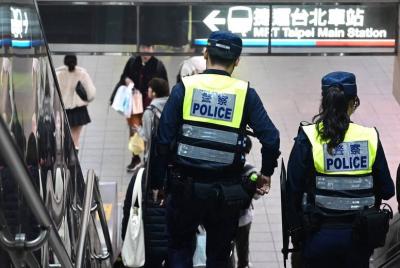The government’s dealings with China are “worrisome” because they are conducted in an oblique fashion and without a public consensus, Democratic Progressive Party (DPP) Chairperson Tsai Ing-wen (蔡英文) said yesterday.
Tsai was briefing Japanese media yesterday on the purpose of Sunday’s anti-government demonstration, saying it was to protest against President Ma Ying-jeou’s (馬英九) policies, especially those related to Taiwan-China relations.
Sunday’s rally is also a protest against the government’s proposed amendment to the Assembly and Parade Act (集會遊行法), which would turn Taiwan into a police state if passed, she said.
The passage of the act, she warned, would restrict people’s freedom to speak and assemble. This would be the antithesis of democracy, she said.
The DPP will provide more details on the protest at an international press conference today.
Meanwhile, Chinese Nationalist Party (KMT) caucus deputy secretary-general John Wu (吳志揚) urged the DPP to cancel its rally on Sunday.
Citing a poll conducted by the Chinese-language China Times yesterday that said 56.1 percent of respondents were satisfied with the Ma administration’s performance over the past year, up from 45 percent in another poll last month, Wu told a press conference that the legitimacy of the DPP’s rally would be questioned.
KMT caucus secretary-general Yang Chiung-ying (楊瓊瓔) said: “The DPP should understand that improvement in the economy, rather than political wrangling, is the public’s first priority.”
The poll surveyed 1,019 people earlier this week and showed an increase of 11.2 percentage points in Ma’s rating since a poll taken last month. His rating is up from 35.5 percent in July when Taiwan fell victim to the global financial downturn.
In related news, pan-blue camp Taipei City councilors yesterday condemned Taipei City’s Department of Transportation for failing to present complete traffic control measures on Monday for the DPP’s sit-in protest, urging the department to protect the “rights of the majority.”
The DPP obtained a permit to hold a rally on Ketagalan Boulevard on Sunday, but decided not to apply for permission for the sit-in protest that will last until Monday.
New Party Taipei City Councilor Wang Hung-wei (王鴻薇) said although the DPP refused to make the 24-hour sit-in protest legal by applying to the Taipei City Government for permission, the department should still draw up traffic control measures for people who need to work on Monday.
“The sit-in protest is two days away and the department has only presented a traffic control plan for the rally on Sunday. The traffic on Monday is what we are concerned about because most people will be returning to work,” she said yesterday at the Taipei City Council.
New Party Taipei City Councilor Hou Kuang-chun (侯冠群) also demanded that the department and Taipei City’s Police Department present a traffic plan so that those who need to visit National Taiwan University Hospital or go to schools near the Presidential Office would not be affected by the sit-in.
Fang Yang-ning (方仰寧), director of Taipei City Police Department’s Traffic Division, said it would implement flexible traffic controls on Monday as it was difficult to estimate the exact number of protesters who will stay for the sit-in. Fang, who handled traffic control during the 24-hour sit-in protest against then president Chen Shui-bian (陳水扁) in 2006, promised to make sure students and patients would be able to enter the area unimpeded.
ADDITIONAL REPORTING BY FLORA WANG AND AFP

Beijing could eventually see a full amphibious invasion of Taiwan as the only "prudent" way to bring about unification, the US Department of Defense said in a newly released annual report to Congress. The Pentagon's "Annual Report to Congress: Military and Security Developments Involving the People's Republic of China 2025," was in many ways similar to last year’s report but reorganized the analysis of the options China has to take over Taiwan. Generally, according to the report, Chinese leaders view the People's Liberation Army's (PLA) capabilities for a Taiwan campaign as improving, but they remain uncertain about its readiness to successfully seize

Taiwan is getting a day off on Christmas for the first time in 25 years. The change comes after opposition parties passed a law earlier this year to add or restore five public holidays, including Constitution Day, which falls on today, Dec. 25. The day marks the 1947 adoption of the constitution of the Republic of China, as the government in Taipei is formally known. Back then the Chinese Nationalist Party (KMT) governed China from Nanjing. When the KMT, now an opposition party in Taiwan, passed the legislation on holidays, it said that they would help “commemorate the history of national development.” That

Taiwan has overtaken South Korea this year in per capita income for the first time in 23 years, IMF data showed. Per capita income is a nation’s GDP divided by the total population, used to compare average wealth levels across countries. Taiwan also beat Japan this year on per capita income, after surpassing it for the first time last year, US magazine Newsweek reported yesterday. Across Asia, Taiwan ranked fourth for per capita income at US$37,827 this year due to sustained economic growth, the report said. In the top three spots were Singapore, Macau and Hong Kong, it said. South

Police today said they are stepping up patrols throughout the Taipei MRT system, after a social media user threatened to detonate a bomb at an unspecified station this afternoon. Although they strongly believe the threat to be unsubstantiated, Taipei Metro police and the Railway Police Bureau still said that security and patrols would be heightened through the system. Many copycat messages have been posted since Friday’s stabbing attacks at Taipei Main Station and near Zhongshan MRT Station that left three dead and 11 injured, police said. Last night, a Threads user in a post said they would detonate a bomb on the Taipei